
7 ideas to pair Kniphofia
Successful pairings with red-hot poker!
Contents
Kniphofia or red-hot poker certainly doesn’t go unnoticed in gardens! Its elongated, leathery foliage resembles that of an Aloe, and its spike-like inflorescences leave no one indifferent. It can don vibrant colours, from bright yellow to cream white, and thrives in any soil, even slightly dry and poor. It enjoys the sun, which highlights its colourful spikes, simultaneously attracting pollinating insects. So why deprive your flowerbeds of its elegant silhouette when it’s not even difficult to grow? To help you find a spot for this fantastic perennial, also known as Tritoma, here are some inspirations. From the most natural to the most graphic, you’re sure to find one(s) to replicate in your little (or large) piece of nature!
In a border between the wild and the orderly
The English are indeed champions at showcasing perennials in stunning arrangements! Here, a stream of water flows into a lovely round pond, surrounded by colourful plantings in a beautifully controlled natural style. Even without a pond to feature, you can take inspiration from this and plant these impressive Kniphofia ‘Flamenco’: modest in height at 60cm, they bloom from July to September. They are accompanied by the rudbeckias Echinacea ‘Red Knee High’ with intense pink flowers and Dahlias ‘Charles de Gaulle’ adding a touch of garnet with their blooms. A few grasses like Chinese fountain grass and Miscanthus enhance the natural and wild aspect, and there you have it! A display created with easy-to-grow plants for a summer full of flowers!

The composition between natural and control, featuring details of Kniphofia ‘Flamenco’, Echinacea ‘Red Knee High’ and Dahlia ‘Charles de Gaulle’
By the water
Imagine: the sky reflects in the waters of a pond, where a few ducks frolic. Frogs dive at the approach of the gardener (not the female gardener; she doesn’t scare them…) and dragonflies flit about… Yes, we’re getting a bit carried away, but a touch of poetry never hurts! At the edge of this pond – sorry, this lake – a herbaceous border hosts insects and little critters of all kinds. Among them (the herbaceous plants, not the critters…) majestic Kniphofia ‘Elvira’ rise to 1m with their charming orange spikes. Their delightful foliage, light and airy, sways with the wind, just like the plump purple spikes of Sanguisorba officinalis ‘Arnhem’ (flowering period from June to August). Closer to the water, where it loves to soak its feet (well, rather its roots), Pontederia cordata displays its stunning deep lavender blue inflorescences from June to September alongside the Water Clover Menyanthes trifoliata, which will have bloomed from April to June. Majestically dominating the scene with its beautiful pure white umbels from June to October is the Baltic Parsley Cenolophium denudatum.
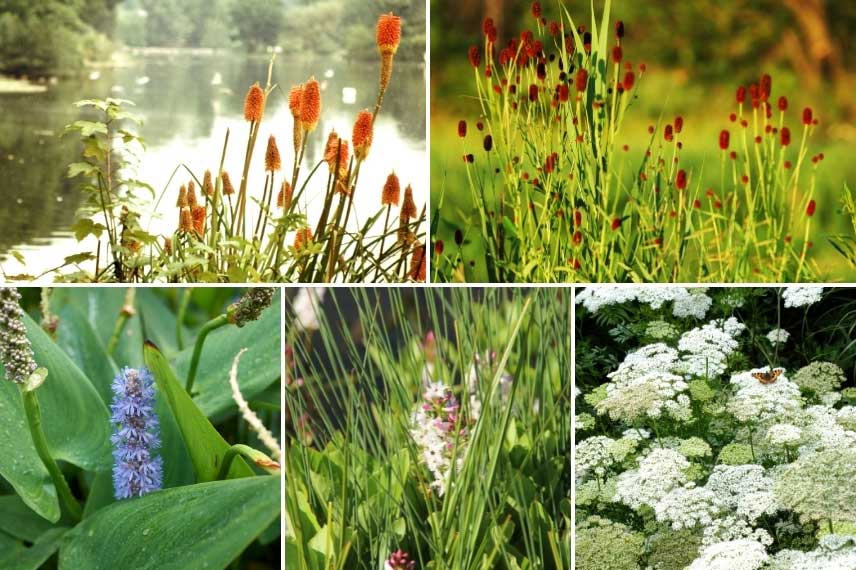
Kniphofia ‘Elvira’, Sanguisorba officinalis ‘Arnhem’, Pontederia cordata, Menyanthes trifoliata and Cenolophium denudatum.
Discover other Kniphofia - Red-Hot Pokers
View all →Available in 0 sizes
Available in 2 sizes
Available in 2 sizes
Available in 1 sizes
Available in 2 sizes
Available in 1 sizes
Available in 1 sizes
Available in 2 sizes
Available in 1 sizes
Available in 1 sizes
In a captivating garden
The graphic appearance of Tritomas and their foliage gives them an exotic look: an opportunity to combine them in a dry garden with a refreshing style. Depending on your soil, it is essential to ensure proper drainage, which is crucial for the good development of the species in this display. The imposing and magnificent Beschorneria yuccoides will unfurl its broad leaves alongside the prickly pears Opuntia dulcis and Opuntia cylindrica. The advantage of Beschorneria yuccoides is that it has very flexible leaves despite their appearance, and they are completely non-spiky. If the thorns of the prickly pears make you fear painful stings during gardening sessions or pose a potential danger to children, consider planting thornless varieties like Opuntia microdasys ‘Caress’ or Opuntia cacanapa ‘Ellisiana’. These prickly pear cacti are perfectly hardy as they easily withstand temperatures of -10 to -15°C and tolerate very poor and dry soils, provided they are well-drained. In June and July, their flowering in shades of yellow or orange is stunning. Alongside these beautiful “exotics,” Kniphofia ‘Ice Queen’ will shine with its tall silhouette reaching over 1m in height and its lovely elongated flowers transitioning from soft green to lemon yellow from July to late August. This variety is hardy to -15°C, enjoys full sun, and prefers well-drained but fertile soils.
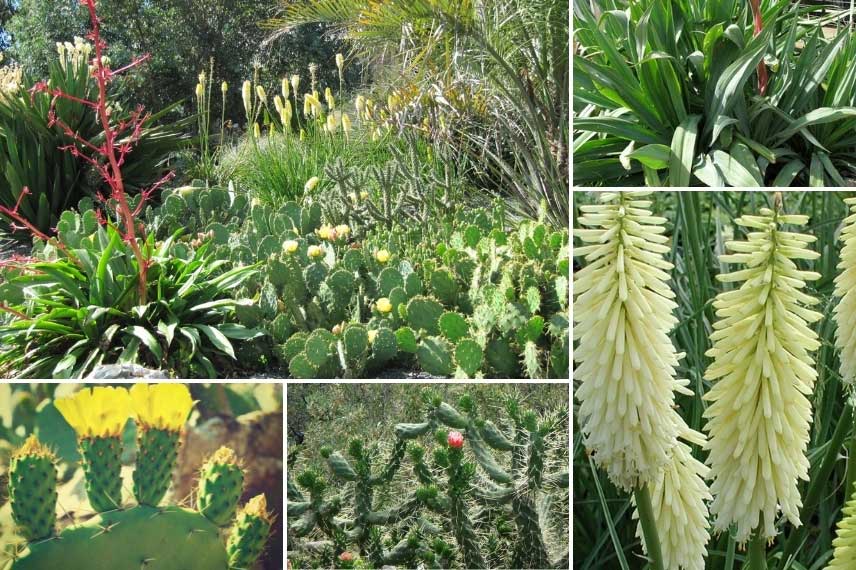
Clockwise: the overall composition, details of Beschorneria yuccoides, Kniphofia ‘Ice Queen’, Opuntia dulcis and Opuntia cylindrica
Read also
Choosing a kniphofiaIn a visually structured and graphic presentation
Of graphic and contemporary style, a grass garden can enhance a minimalist home where concrete and wood complement each other. The Kniphofia uvaria, is the ideal plant to warm up this raw and stripped-back atmosphere. Its tall stems are very graphic and seem to reach for the sky. From spring until the end of summer, its bi-coloured yellow and orange flowers provide a welcome splash of colour amidst a mass of muhlenbergia rigens. It is a low-maintenance and aesthetically pleasing garden all year round, as these grasses are evergreen and offer a lovely, very fine grey-blue foliage. At the end of summer, a multitude of spikes rise to over 1.5m high, remaining decorative throughout winter. The agave americana completes the picture. Its broad blue-tinged leaves are stunning and provide an equally graphic presence. However, be careful not to let it take over the space with its rosettes suckering from the base. These will need to be regularly removed, or you could plant a less invasive variety like the Agave montana.
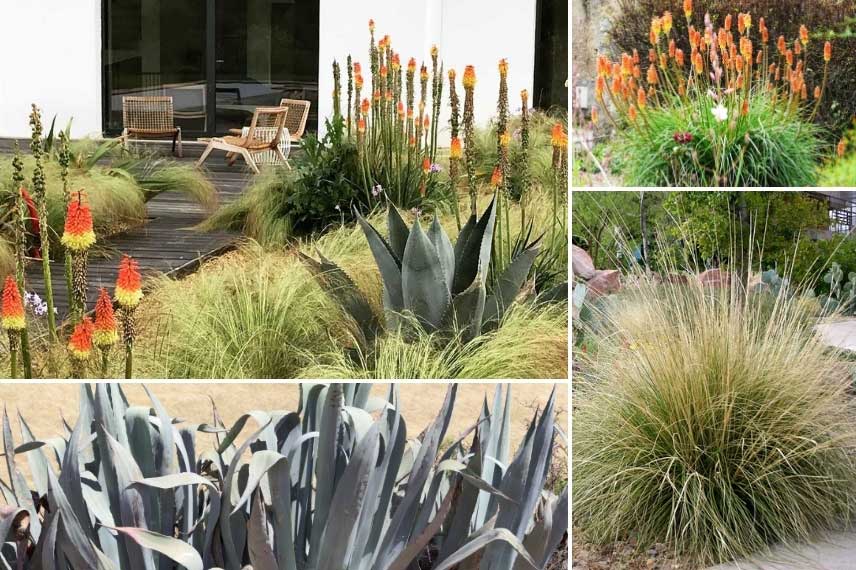
Clockwise: the overall composition, details of Kniphofia uvaria, muhlenbergia rigens and agave americana
In a soft summer gradient
Prodigal in delightfully coloured flowers, summer perennials grow so quickly that in no time they achieve the height and stature needed to create three-dimensional mass effects. Many are the flowerings with which Tritomas can be associated. For a soft and luminous colour scheme, the Persicaria amplexicaulis ‘Orange Field’, flowering from July to October, will dominate the scene. At a height of 1m, this Knotweed produces beautiful coral-pink spikes: a very gentle pairing with the Penstemon ‘Apple Blossom’, with its soft pink bell-shaped flowers at the same time, and the Eryngium giganteum ‘Miss Willmotts Ghost’, with its bluish-grey hue. The Kniphofia ‘Orange Vanilla Popsicle’ will prove very valuable for brightening this plant tapestry with its bicoloured orange-red and cream inflorescences, from late spring to the end of August. It stands at about 45cm, above fine, rigid foliage. The soil that suits it will be well-drained and light; it prefers full sun and is very hardy.
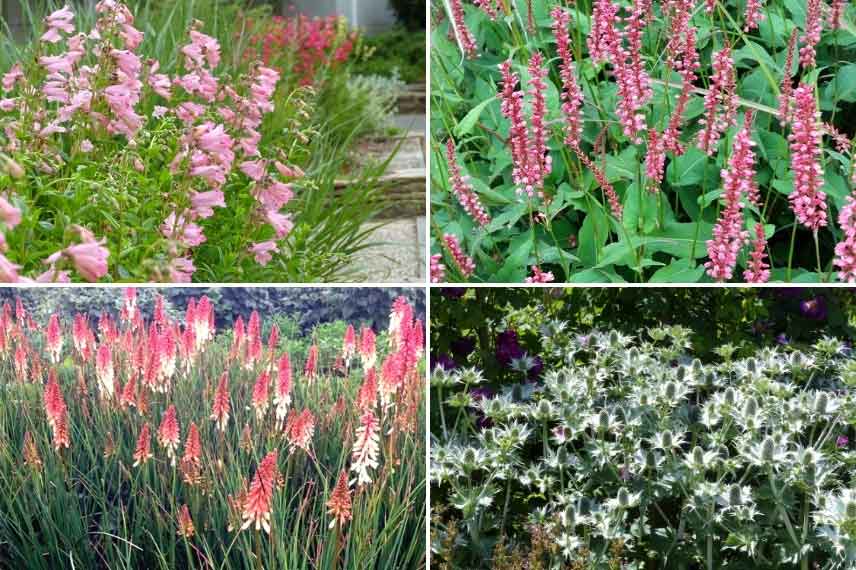
Penstemon ‘Apple Blossom’, Persicaria amplexicaulis ‘Orange Field’, Kniphofia ‘Orange Vanilla Popsicle’ and Eryngium giganteum ‘Miss Willmotts Ghost’
In a contrasting harmony of purple and yellow
Here we discuss a grand carpet, playing with colour reminders brought by flowers of different appearances. The pale yellow spikes of Kniphofia ‘Little Maid’ complement the daisies of Anthemis tinctoria ‘E.C. Buxton’ and the foliage of the grasses. The deep purple of Agapanthus ‘Brilliant Blue’ and Campanula ‘Sarastro’ finds a reflection in the grey foliage of Artemisia ‘Powis Castle’. A lightness tinged with pink from Erigeron karvinskianus pleasantly tempers the whole. The Kniphofia ‘Little Maid’ planted here has a light and delicate silhouette. It blooms from August to October, reaching 60cm in height. It prefers light, rich soils and full sun, just like the other perennials associated with it here.

Clockwise: Kniphofia ‘Little Maid’ and Campanula ‘Sarastro’, Artemisia ‘Powis Castle’, Agapanthus ‘Brilliant Blue’, Erigeron karvinskianus and Anthemis tinctoria ‘E.C. Buxton’
Foliage as precious as flowers
Some foliage, sometimes as colourful as flowers, is rich in an endless variety of shades, shapes, and textures. The most interesting effects arise from mixing beautiful foliage in juxtaposition with a few flowering plants, which serve as highlights in the display. Tritomas blend wonderfully into these compositions partly due to their graphic foliage and partly because of their architectural flower stems. Thus, Kniphofia ‘Fiery Fred’, with its striking orange hue, happily combines with the round leaves of Farfugium japonicum, the dense and fine foliage of Hackonechloa macra ‘Aureola’, the purple of Heuchera ‘Fire Chief’, and the golden hue of Origanum vulgare ‘Aureum’.
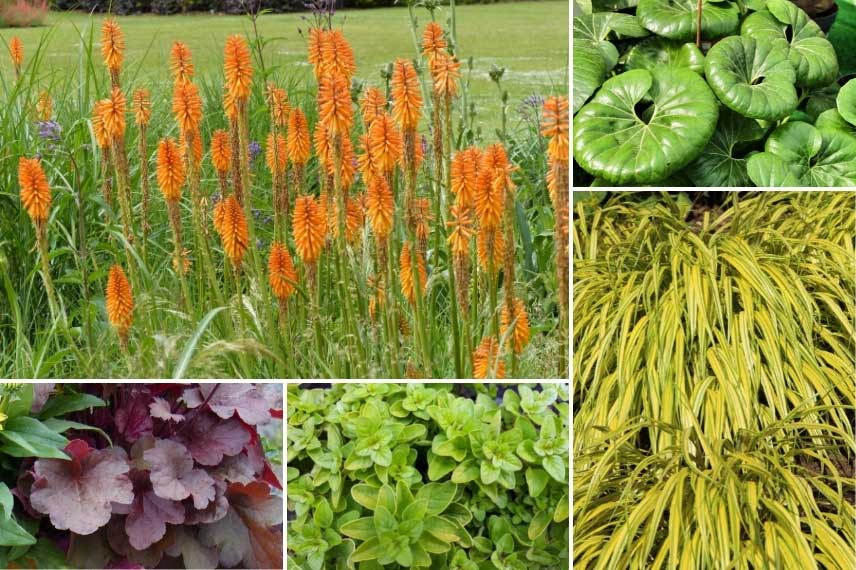
Clockwise: Kniphofia ‘Fiery Fred’, Farfugium japonicum, Hackonechloa macra ‘Aureola’, Origanum vulgare ‘Aureum’ and Heuchera ‘Fire Chief’
For further reading
- Follow our guide to help you choose a kniphofia.
- Subscribe!
- Contents
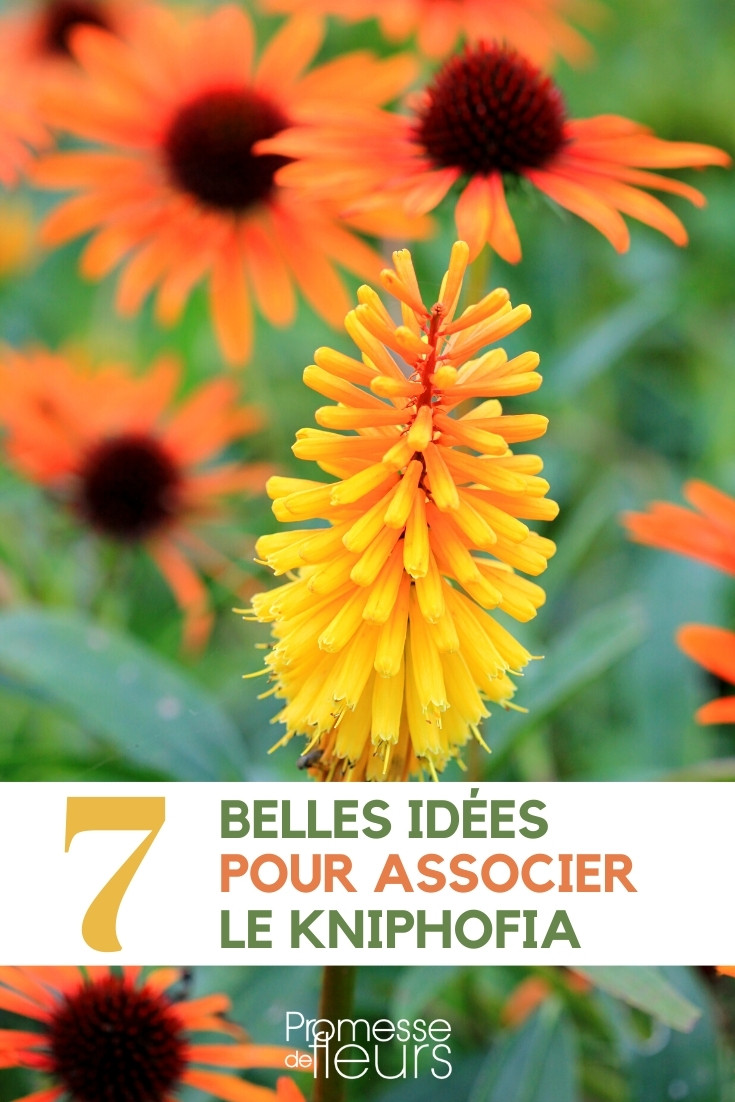































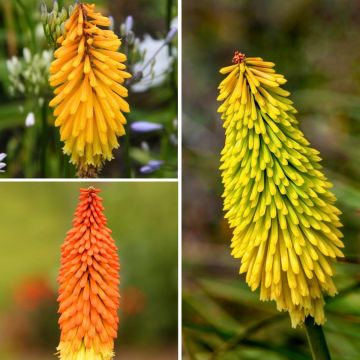
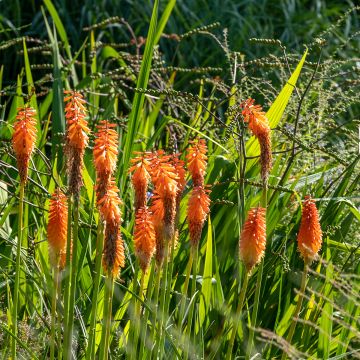


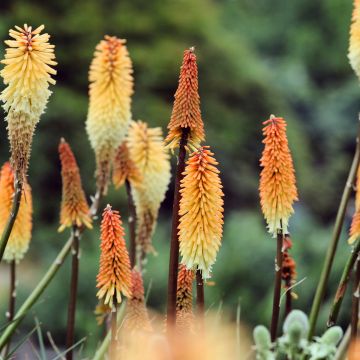

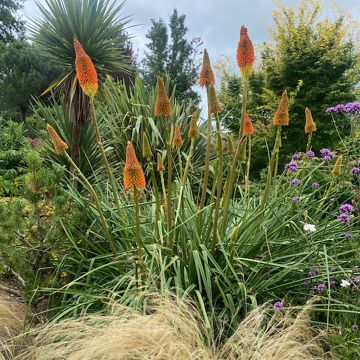
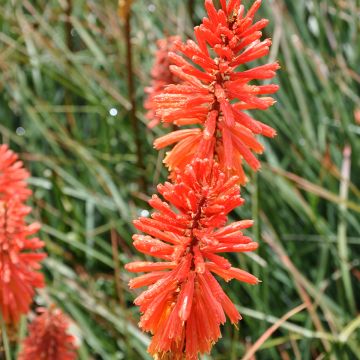
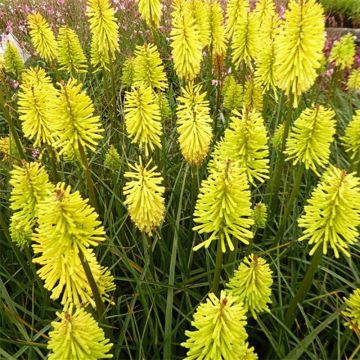
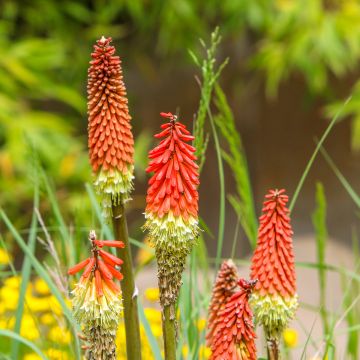
Comments